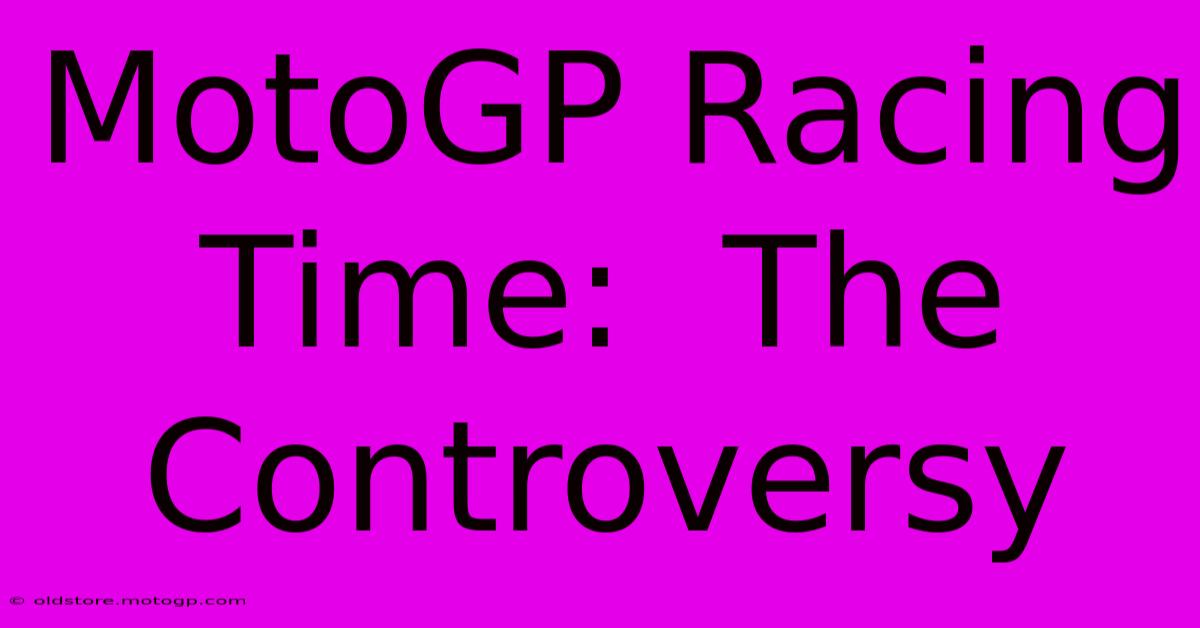MotoGP Racing Time: The Controversy

Table of Contents
MotoGP Racing Time: The Controversy
MotoGP, the pinnacle of motorcycle racing, is a sport defined by milliseconds. A race can be won or lost by the blink of an eye, making the precise measurement of racing time a crucial, and often controversial, element. This article delves into the complexities surrounding MotoGP racing time, exploring the technological aspects, the inherent human error, and the resulting controversies that frequently ignite passionate debates among fans and within the sport itself.
The Technology Behind the Timing
The timing system used in MotoGP is incredibly sophisticated, designed to record lap times and race times with exceptional accuracy. Transponders affixed to each motorcycle transmit signals to sensors located around the track. These signals are processed by a central timing system, generating incredibly precise data down to thousandths of a second. This technology is constantly being refined to improve accuracy and reliability, minimizing the potential for errors. However, even with cutting-edge technology, challenges remain.
Potential Sources of Error:
- Transponder malfunction: Although rare, transponder failure can lead to inaccurate lap times or even a complete loss of data for a rider.
- Signal interference: Environmental factors, such as radio frequency interference, can occasionally disrupt the signal transmission from the transponders to the timing system.
- Sensor issues: Problems with the trackside sensors themselves, though rare, can also affect the accuracy of the timing data.
The Human Element: Photo Finish and Race Direction Decisions
While technology plays a significant role, human intervention remains a crucial element in determining race results. Photo finishes, for example, are still necessary in close finishes, requiring careful examination by officials to determine the winner. This adds a layer of subjectivity, leading to potential disputes and controversies.
Furthermore, race direction plays a crucial role in adjudicating incidents during the race. Penalties for exceeding track limits, causing collisions, or other infractions can significantly impact a rider's final race time, sometimes resulting in post-race changes to the official classification. These decisions are often subject to intense scrutiny and debate.
Controversial Decisions and their Impact:
The subjective nature of these decisions regularly sparks controversies. A controversial penalty, for instance, can shift the race outcome, leading to accusations of bias and fueling strong reactions from teams, riders, and fans. The lingering questions over the fairness and consistency of these decisions often overshadow the thrilling on-track action.
The Importance of Transparency and Consistency
To maintain the integrity of the sport, MotoGP needs to strive for transparency and consistency in its timing and race direction processes. Clearly defined rules and regulations, along with robust appeals processes, are essential to addressing disputes and restoring confidence. Open communication regarding timing anomalies and race direction decisions is crucial in fostering trust among all stakeholders.
Improving the System:
Potential improvements include:
- Enhanced data analysis: Implementing more advanced data analytics to identify and flag potential timing inconsistencies more effectively.
- Standardized penalty application: Developing more consistent and transparent criteria for applying penalties to ensure fairness and prevent subjective interpretations.
- Independent review processes: Establishing independent review bodies to investigate controversial decisions and enhance accountability.
Conclusion:
The precision of MotoGP racing time is paramount, yet the system isn't without its imperfections. The interplay between sophisticated technology and the unavoidable human element creates an environment ripe for controversy. By focusing on greater transparency, improved technology, and consistent application of rules, MotoGP can address these challenges and strengthen the credibility of its thrilling races. The future of MotoGP’s timing and race direction systems will likely involve continuous refinement and technological advancements to minimize ambiguity and maximize fairness.

Thank you for visiting our website wich cover about MotoGP Racing Time: The Controversy. We hope the information provided has been useful to you. Feel free to contact us if you have any questions or need further assistance. See you next time and dont miss to bookmark.
Featured Posts
-
Mastering Cota Parking Your Race Day Advantage
Feb 18, 2025
-
Yamaha Moto Gp Racing Facing The Challenges
Feb 18, 2025
-
Moto Gp Qualifying Insider Tips For Understanding The Process
Feb 18, 2025
-
The Cota Fans Essential Merchandise Guide
Feb 18, 2025
-
Cota Circuit Days Where Dreams Come True
Feb 18, 2025
